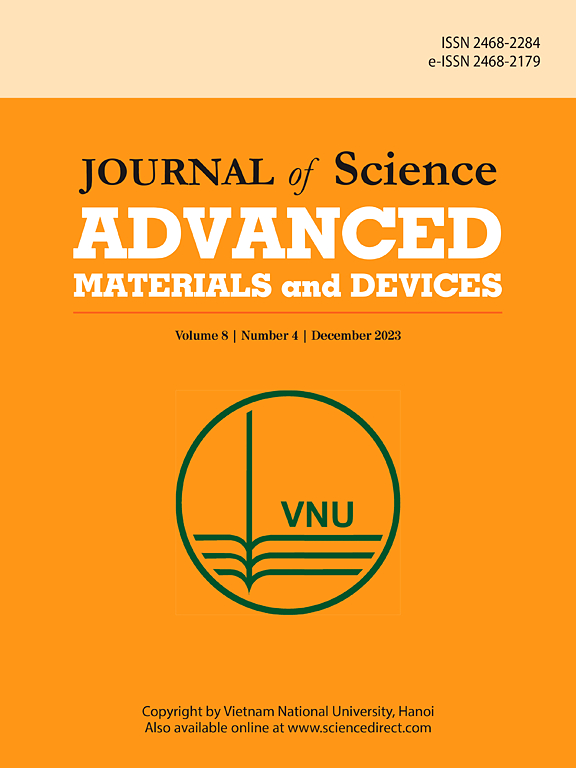Fabrication and wetting characteristics of copper thin film: An active layer for SPR-based sensor applications
IF 6.7
3区 材料科学
Q1 MATERIALS SCIENCE, MULTIDISCIPLINARY
Journal of Science: Advanced Materials and Devices
Pub Date : 2024-12-22
DOI:10.1016/j.jsamd.2024.100839
引用次数: 0
Abstract
In this work, a simple and two-step process was demonstrated to develop multifunctional Cu-based thin films that would be suitable for thin film photoactive devices. Cu thin films on quartz glass substrates were prepared using a sputtering technique followed by a thermal treatment. The samples were annealed at high temperatures such as 200, 400, and 600 °C for 2 h in a tubular furnace. Surface morphology and elemental composition were investigated using a high-resolution scanning electron microscope (FESEM) and SEM-aided energy dispersion spectroscopy (EDS), respectively. At high temperatures, the thin films were found to have clusters and voids. Detailed studies on optical properties such as ultraviolet–visible (UV–vis) absorptions, energy band gaps and Urbach energies have been carried out. A red shift in absorption edges (from 464 to 616 nm), a decrease in energy band gaps (from 2.38 to 1.54 eV) and an increase in Urbach energies (from 193 to 272 meV) were observed for those samples annealed at higher temperatures. Sessile drop tests were carried out to find the wetting contact angle (WCA) and to demonstrate the hydrophobicity of the thin film of pristine Cu and those treated at high temperatures. An approximate WCA of 71.9° was determined for the Cu thin film. Following treatment at 200 °C and 400 °C, respectively, the samples' surfaces increased in hydrophobicity by 92.4° and 85.2°. Nevertheless, the same thin film's WCA was decreased and its hydrophilicity increased during additional annealing. Cu-based thin films have been suggested as the active layer in an SPR sensor model, and the spectrum and angular resolved reflectance properties have been thoroughly investigated. At spectral wavelengths of 600, 700, and 800 nm, the optimum thickness of Cu thin film was determined to be 40 nm at SPR angles of 44.7°, 42.7°, and 42.15°.

铜薄膜的制备和润湿特性:用于基于spr的传感器应用的有源层
在这项工作中,展示了一种简单的两步法来开发适用于薄膜光活性器件的多功能铜基薄膜。采用溅射和热处理技术在石英玻璃衬底上制备了Cu薄膜。样品在管式炉中分别在200、400和600℃高温下退火2 h。利用高分辨率扫描电子显微镜(FESEM)和扫描电子能谱仪(EDS)对其表面形貌和元素组成进行了研究。在高温下,发现薄膜有团簇和空隙。对其紫外-可见吸收、能带隙和乌尔巴赫能等光学特性进行了详细的研究。高温退火后的样品吸收边红移(从464 nm到616 nm),能带隙减小(从2.38 eV到1.54 eV),乌尔巴赫能增加(从193 meV到272 meV)。通过固滴试验,确定了原始Cu薄膜的润湿接触角(WCA),验证了原始Cu薄膜和高温Cu薄膜的疏水性。Cu薄膜的WCA约为71.9°。分别在200°C和400°C处理后,样品表面的疏水性提高了92.4°和85.2°。然而,在进一步退火过程中,同一薄膜的WCA降低,亲水性提高。提出了铜基薄膜作为SPR传感器模型的有源层,并对其光谱和角分辨反射率特性进行了深入的研究。在光谱波长为600、700和800 nm时,在SPR角为44.7°、42.7°和42.15°时,Cu薄膜的最佳厚度为40 nm。
本文章由计算机程序翻译,如有差异,请以英文原文为准。
求助全文
约1分钟内获得全文
求助全文
来源期刊

Journal of Science: Advanced Materials and Devices
Materials Science-Electronic, Optical and Magnetic Materials
CiteScore
11.90
自引率
2.50%
发文量
88
审稿时长
47 days
期刊介绍:
In 1985, the Journal of Science was founded as a platform for publishing national and international research papers across various disciplines, including natural sciences, technology, social sciences, and humanities. Over the years, the journal has experienced remarkable growth in terms of quality, size, and scope. Today, it encompasses a diverse range of publications dedicated to academic research.
Considering the rapid expansion of materials science, we are pleased to introduce the Journal of Science: Advanced Materials and Devices. This new addition to our journal series offers researchers an exciting opportunity to publish their work on all aspects of materials science and technology within the esteemed Journal of Science.
With this development, we aim to revolutionize the way research in materials science is expressed and organized, further strengthening our commitment to promoting outstanding research across various scientific and technological fields.
 求助内容:
求助内容: 应助结果提醒方式:
应助结果提醒方式:


